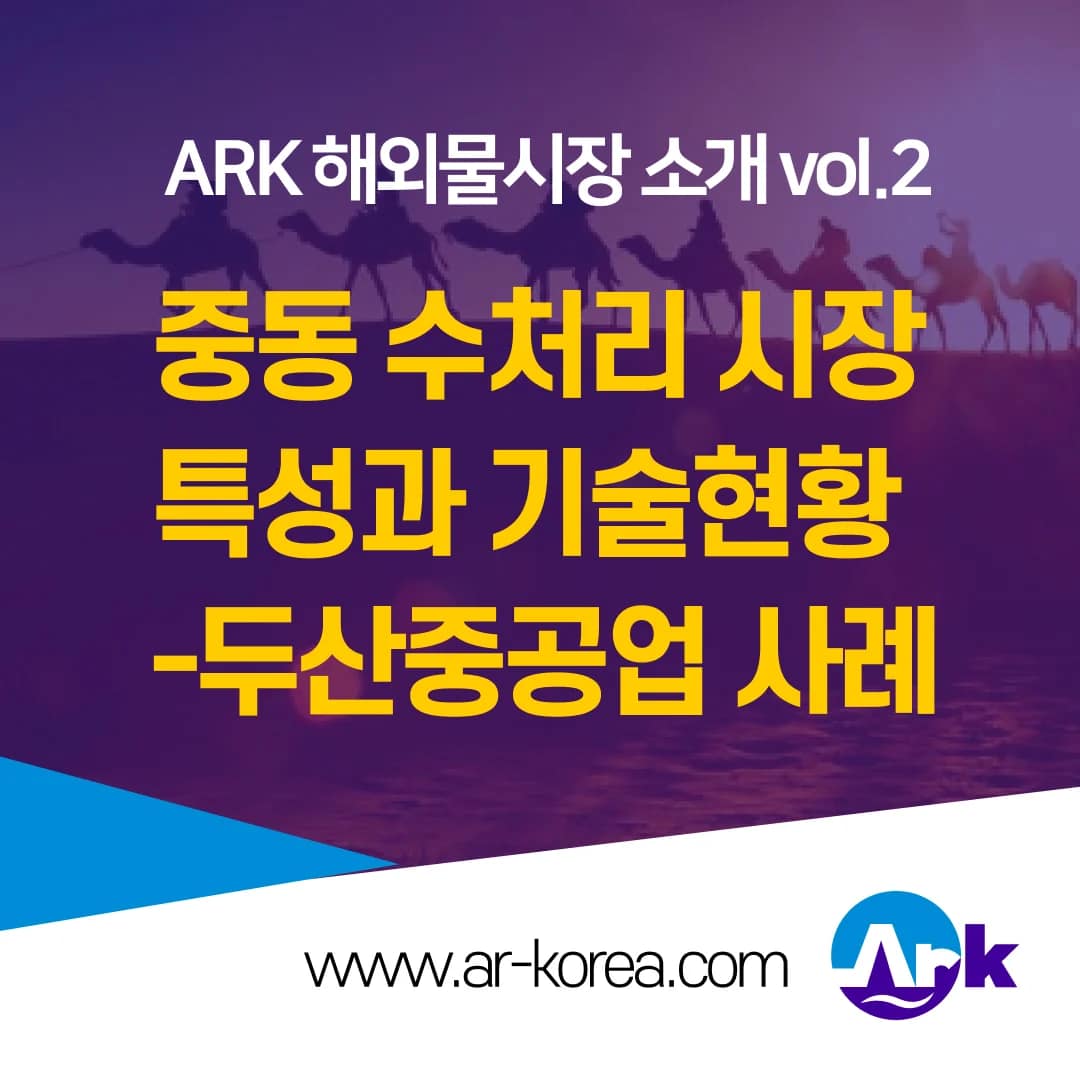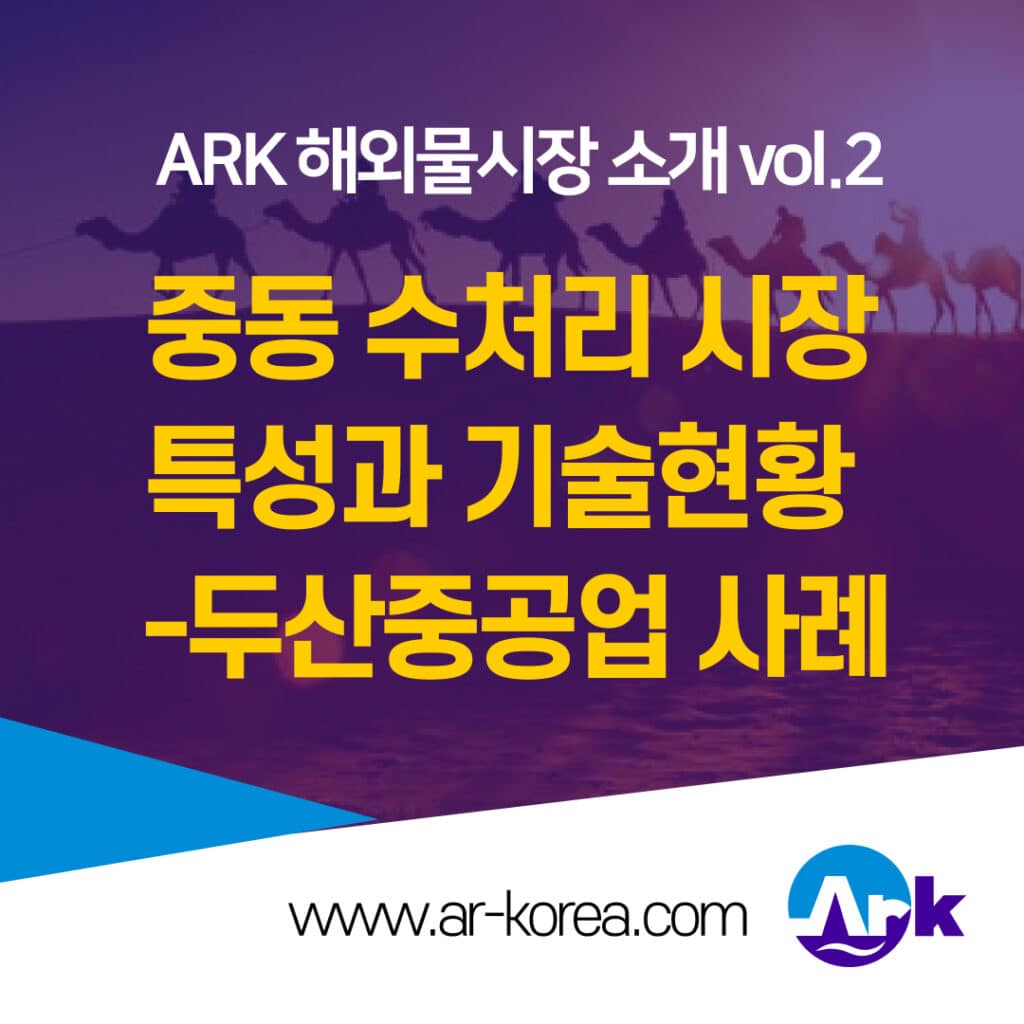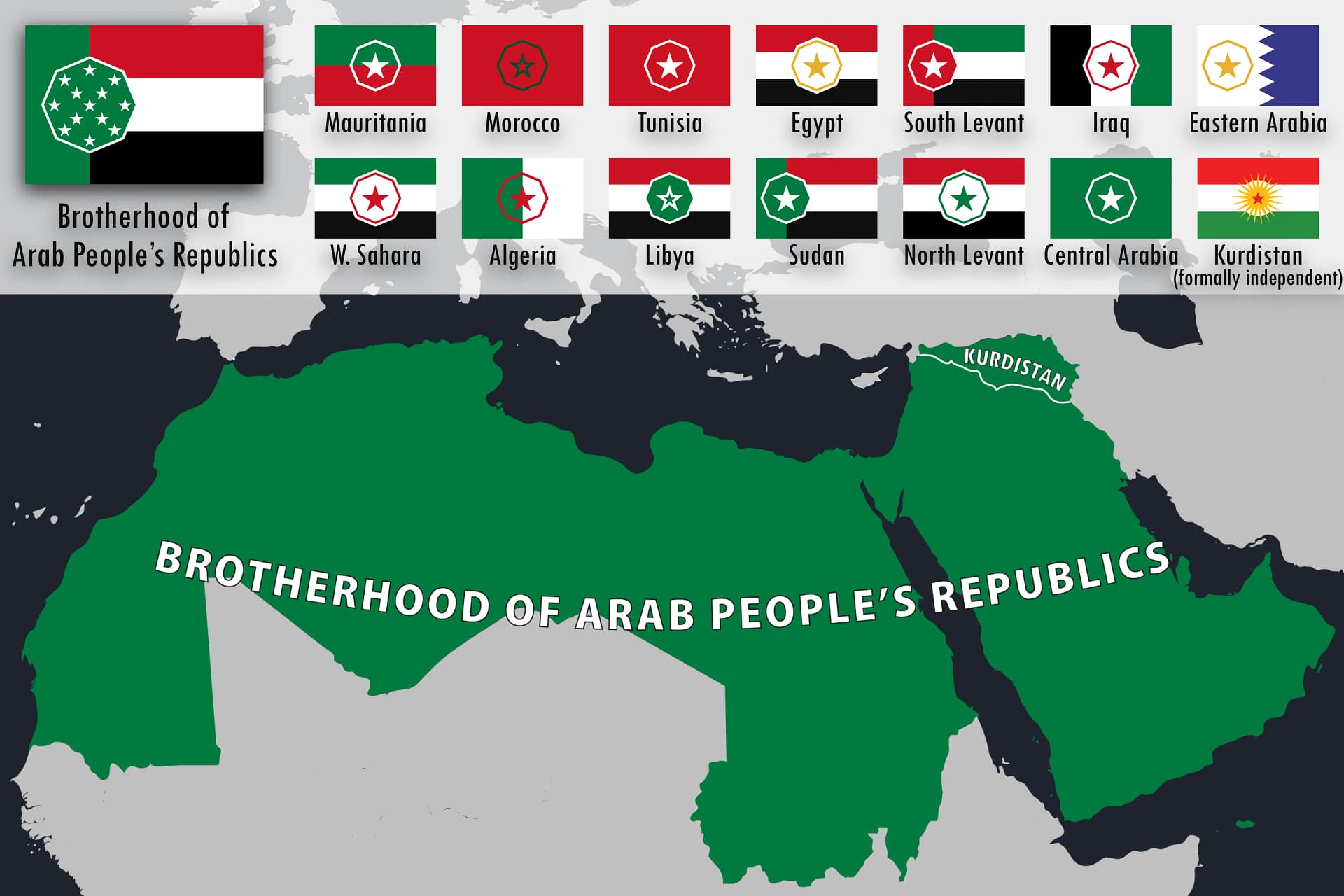

Solutions in Water Environment
for People and Planet


Hello, this is ARK PR. This is ARK Overseas Water Market News vol.2, where we talk about the recent overseas water treatment market.
Past vol.1 "『Indonesia's Water Treatment Market Status and Cases of Korean Companies Entering the Market explained the current status of the project and associated water purification plant, which is a consortium of the Korea Water Resources Corporation and the Indonesian government.
This time, we're talking about the water treatment market in the Middle East.
Why do these countries need a more complex challenge rather than the typical process of water source > water supply > water treatment > wastewater treatment > reuse that is typically required?
The Middle East is an oil-producing region and is so arid that some countries have freshwater drinking water sources that are not even 1%, or even if they do have water intake sources such as dams, they cannot rely on groundwater blindly due to ground subsidence and increasing salinity.
때문에 중동국가는 ‘해수담수화’가 첫 번째로 풍부하게 공급되어야 하는 난제가 있으며 이로인해 필터와 역삼투기술에 대한 수요는 지난 해수담수화가 처음 시작된 50년대 부터 계속 있어왔습니다.
Let's take a look at what's involved.


As you can see in the picture, North Africa and West Asia are collectively referred to as the Middle East, and the countries that make up this region are categorized as follows.
Arab League (United Arab Emirates)
Lebanon, Bahrain, Saudi Arabia, Syria, United Arab Emirates, Yemen, Oman, Jordan, Iraq, Egypt, Qatar, Kuwait,Palestine
Non-member countries
Iran
Afghanistan
Israel
The United Arab Emirates, the core of the Arab League in the Middle East, is mountainous and consists mainly of desert and coastal areas.
In addition, the UAE is the world's sixth largest oil driller and is classified as an economic powerhouse. Although the country is classified as an economic powerhouse due to its abundant oil reserves, it has a geopolitical feature that makes it difficult to produce crops due to its scarce water sources and dry climate.
We can't judge every country in the Middle East, so we'll use the water resources of the United Arab Emirates as a standard.
In the Arab world, desalination and groundwater are used to supply water resources for domestic and industrial use. In the capital Abu Dhabi, groundwater accounted for 711 TP3T of the total supply by the early 2000s, while desalination accounted for 251 TP3T and wastewater reuse for 51 TP3T.
Source: Water features in the United Arab Emirates, Middle East
However, groundwater is not an infinite resource, it's a ticking time bomb with issues of relationships and land subsidence, and global warming-induced El Niño, where a year's worth of rainfall is suddenly dumped on a normally scarce area, killing 5300 people.
The Middle East is also facing a similar situation with groundwater subsidence in Indonesia, where desalination is becoming more important to meet the growing need for drinking water due to increasing urbanization than the use of groundwater.

Another problem in the Middle East, also evident in 2023, is not only water supply issues, but also the city's drainage system for sudden heavy rains due to the effects of El Niño.
대한민국과 인연이 깊은 중동은 석유의존도를 낮추고 사막에서의 식량생산을 늘리는 한편 원전가동과 최첨단 재생에너지의 생산을 늘리는 움직임을 취하며 ‘네옴시티(Neom)’ 프로젝트를 진행 중 입니다.
Therefore, various water treatment needs are required according to the National Project Plan, including the following needs.

Source: Doosan Heavy Industries & Construction website (Shuaibah Ph.3 IWPP & Expansion RO, Saudi Arabia)
Desalination of seawater began as a technology developed during World War II to supply water to the military, and the first desalination plant was built in Kuwait in 1956. By the 70s, large-scale desalination plants were built in most of the Middle East.
Now a necessity in most of the desert and mountainous Middle Eastern countries, there is a greater demand for seawater desalination, wastewater treatment, water purification technologies, and water reuse.
Water supply is the number one priority in urban functioning, so water treatment technology in Middle Eastern countries is required at a higher level.
The Gulf, in particular, has high pollution and salinity due to its tendency to stagnate, which is where Doosan Energy has conducted major projects.
대한민국의 해수담수화는 세계1위로 평가받으며, 두바이엔 두산중공업이 운영하는 ‘해수담수화 R&D’센터가 있어 ‘푸른두바이’를 이루기 위한 다양한 연구개발을 진행합니다.
In the UAE, Doosan Heavy Industries & Construction's technology at the Fujairah Desalination Plant turns an average of 450,000 tons of desalinated water per day into fresh water, which, after post-treatment, is supplied to 1.5 million citizens in the UAE/Dubai.
Note : Doosan Heavy Industries & Construction to develop advanced seawater desalination technology in Saudi Arabia | Doosan Heavy Industries & Construction Water Treatment Introduction Version 10
Once the primary water source has been successfully desalinated in a seawater desalination plant, water and wastewater infrastructure must be built to supply it, followed by water treatment, wastewater treatment, and water reuse infrastructure to ensure a stable source of drinking water.
Doosan Heavy Industries & Construction is the Korean company with the most diverse and experienced project track record in the Middle East.
In general, even in countries with abundant water resources such as dams and rivers, water reuse and re-supply by reusing sewage and wastewater is becoming essential as the urban population grows.
In the Middle East, in particular, the need for sewage wastewater treatment and reuse is much greater than in other economies, even when water is supplied through desalination. The reuse of sewage wastewater has emerged as a viable alternative to scarce water resources and is being actively explored in water-scarce regions because it can be produced with low investment costs.
Drinking water is increasingly requiring sophisticated treatment techniques. As urbanization progresses, dietary habits change, shifting from vegetarian to meat-based diets, and life expectancy increases, the number of elderly people has increased, resulting in more hospitals.
Water treatment used to be all about removing suspended solids, turbidity, and general bacteria, but with the rise of hospitals, increased regulation has become a necessity in high-density cities.
Therefore, advanced water treatment is required to treat certain pathogenic microorganisms and prevent carcinogenic substances.
In addition, global warming has led to blue-green algae blooms, making the removal of algae from water sources essential. Without advanced water treatment, blue-green algae can enter the tap water supply and cause serious effects such as infertility and liver cancer if consumed at levels above the threshold.
This need drove the need for Dissolved Air Floatation (DAF).
Doosan Heavy Industries & Construction, Korea's leading water treatment company, provides conventional water treatment facilities, membrane filtration processes (UF/MF, NF, RO, etc.), advanced water treatment facilities such as Advanced Oxidation Process (AOP), and high-speed pressurized flotation technology for algae removal. Doosan Heavy Industries & Construction also has a wide range of related supply experience around the world, and provides auxiliary facilities such as optimized water intake facilities, drainage facilities, and pipelines.
The need for industrial water is a major concern in industrialized countries with semiconductor industries. Since semiconductors require ultra-pure water, industrial water purification is an extremely advanced technology with a very large technology gap.
The quality of ultra-pure water for semiconductor applications is a major factor affecting plant operations.
Doosan Heavy Industries & Construction has experience in supplying water purification equipment for many power plants, and we supply equipment that meets the water quality requirements of industries such as petrochemical and refining, semiconductor, beverage, and pharmaceutical. We provide reliable and cost-effective customized solutions based on the characteristics of industrial water.
The industrial water needed in the Middle East is in the demineralization process used in power plants.
In Korea, Doosan Heavy Industries & Construction and Hyundai Heavy Industries & Construction are representative companies with diverse portfolios in the Middle East, and recently, Kolon Global, a leading water treatment powerhouse, is accelerating its expansion into the Middle East by applying various new technologies.
Modern urban societies share a common problem: the generation of sludge from sewage wastewater and the high cost of disposing of it. Sludge contains contaminants and retains water, which must be dewatered in centrifugal dewatering machines to dry it out before it is disposed of in landfills.
The average amount of sewage sludge generated in Korea is 2,022,374 tons as of 2021. The average amount of sewage sludge generated by each household is 95 kilograms per year, and most of the sludge is incinerated or landfilled.
Currently, the company is interested in this and sells fuel coal to power plants, sometimes trading at 100,000 won per ton.
The Middle East is very interested in reuse of sludge, which is a big problem, and they want it to be reused at a high level.
The following advanced sewage treatment technologies are being applied in the Middle East.
Sludge is usually incinerated or landfilled after dewatering, but when it is buried in the soil, microorganisms take a lot of energy and time to decompose it, causing soil pollution. Therefore, various recycling methods are being tried, such as biogas production through anaerobic digestion, phosphorus recovery, and fueling for power generation.
Sludge resourcing facilities for this purpose are now becoming a necessity rather than an optional extra in plant commissioning.
Zero Liquid Discharge (ZLD) is a technology that grew out of the idea that no discharge means no pollution. It is the most advanced wastewater treatment process available today that can produce high-purity reuse water while simultaneously achieving the goal of zero discharge.
Zero-discharge treatment facilities are not intended for municipal wastewater treatment systems, but are mainly applied to refineries, petroleum, chemical, and power plants, where demand is growing significantly.
In particular, the continued reduction in processing unit costs is driving economics.
A zero discharge ZLD system is a system that recovers used water from the plant, vaporizes and cools the clean water, extracts it, and discharges only the contaminants as sludge.
Doosan Heavy Industries & Construction is the first company in the Middle East to apply this zero liquid discharge (ZLD) treatment plant to a petrochemical facility.
As the world's largest seawater desalination supplier, Doosan Heavy Industries & Construction has successfully developed a zero-discharge treatment facility (120 m³/d) based on its know-how in evaporation technologies such as multi-stage evaporation (MSF) and multiple-effect method (MED), and reverse osmosis processes, and is promoting large-scale expansion to more than 4,000 m³/d. It is also carrying out a zero-discharge treatment facility project at a petrochemical facility in Saudi Arabia for the first time in Korea.
ARK is a comprehensive dehydrator developer with 24 years of experience, with a portfolio of dehydrators delivered to all continents including the Middle East, except for African countries on the African continent, and many dehydrators for overseas water purification projects.
With a long history of decanter centrifuges and screw presses, and a factory in Vietnam, there is only one company that develops and supplies decanter centrifuges.
Join us as we build offshore supply hubs.
Stable for international projects Decantercentrifuge If you would like to discuss supply, you are always welcome to visit our headquarters and tour our factory in Vietnam.

